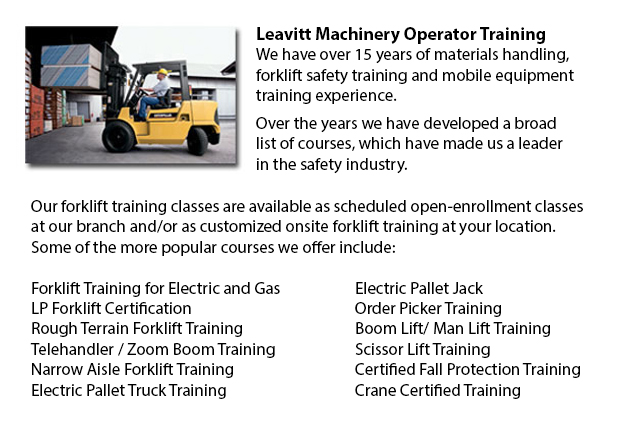
Forklift Training Schools Grande Prairie - Why People Who Utilize A Forklift Need to Take Whichever Of Our Forklift Training Schools
If you are searching for work as a forklift operator, our regulatory-compliant forklift training Schools provide excellent instruction in various styles and types of forklifts, lessons on pre-shift inspection, fuel kinds and handling of fuels, and safe use of a forklift. Practical, hands-on training assists participants in acquiring basic operational skills. Program content comprises existing rules governing the utilization of forklifts. Our proven forklift Schools are designed to offer training on these types of trucks: powered pallet truck, narrow isle forklift and counterbalanced forklift.
When the lift truck is in use, do not raise or lower the forks. Loads must not extend over the backrest. This is due to the danger of the load sliding back towards the operator. Inspect for overhead obstacles and make sure there is plenty of clearance prior to raising a load. Stay away from overhead power lines. When the load is lifted straight up, tilt it slightly back.
The lift truck is less stable when a load is in a raised position. Make certain that no one ever walks below the elevated fork. The operator should not leave the lift truck when the load is raised.
The forks should be level when handling pallets, and high enough to extend all the way into and beneath the load. The fork's width must provide equal distribution of weight.
Chock the wheels and set the brakes prior to unloading and loading the truck. The floors should be strong enough to support the combined weight of the load and the forklift. Fixed jacks could be installed to be able to support a semi-trailer which is not attached to a tractor. The entrance door height must clear the height of the forklift by a minimum of 5 cm. Mark edges of docks, rail cars or ramps and avoid them.
-
Forklift Operator Certification Grande Prairie
Forklift Operator Certification Grande Prairie - Certification for forklifts are needed to ensure the safe utilization of forklifts for those employers in industrial, warehouse or construction environments. The training has to involve a method of edu... More -
Skid Steer Ticket Grande Prairie
Skid Steer Ticket Grande Prairie - On a skid-steer loader, the lift arms are beside the driver along with pivot points behind the driver's shoulders. This makes them different as opposed to a conventional front loader. Due to the operator's proximity... More -
Order Picker License Grande Prairie
Order Picker License Grande Prairie - Order preparation operation or order picking as it is more usually known is a method utilized in warehouse operations and consists of staff referred to as order pickers. The order picker's job is to take and coll... More -
Telehandler Certification Grande Prairie
Telehandler Certification Grande Prairie - Telehandler certification programs are both for operators who have some experience driving a typical forklift and for people with no experience. The real-world training provided by these programs produces gr... More -
Skid Steer Loader Training in Grande Prairie
The engine powered skid-steer loader consists of a small and rigid frame, equipped with lift arms which could attach to numerous industrial attachments and tools in order to perform various labor saving tasks. Typically, skid-steer loaders are four-w... More -
Crane Training School Grande Prairie
Crane Training School Grande Prairie - The crane training school offers industry-relevant programs. Courses provide trainees with learning results that match current industry demands. Our small class sizes combine theory and hand-on experience. Our q... More -
Telehandler License Grande Prairie
Telehandler License Grande Prairie - The telescopic handler or telehandler is a commonly used machine in agricultural and industrial applications. This equipment is similar in look to a forklift and even works in a similar manner, even though telehan... More -
Aerial Boom Lift Ticket Grande Prairie
Aerial Boom Lift Ticket Grande Prairie - Aerial lifts can be utilized to accomplish several unique tasks executed in hard to reach aerial spaces. A few of the odd jobs associated with this kind of lift include performing daily maintenance on structur... More

Forklift Training Grande Prairie
TOLL FREE: 1-888-254-6157
11205-98 Avenue
Grande Prairie, Alberta
forklifttraininggrandeprairie.com
Email Us
About Us



